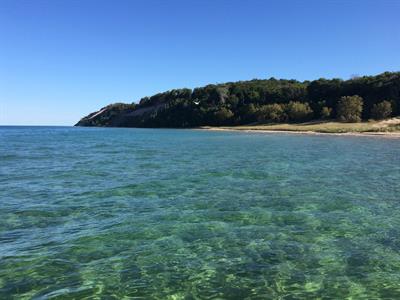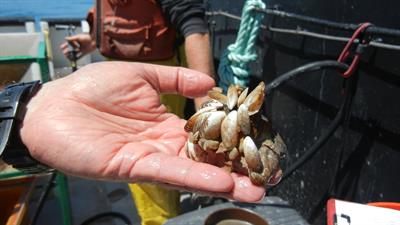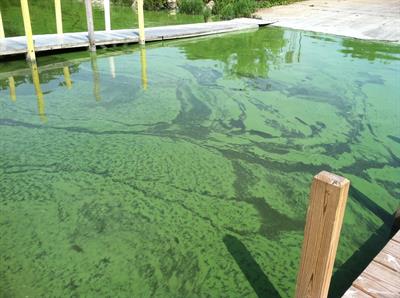Incredible Natural and Economic Resource
 Something about the Great Lakes evokes a sense of timelessness. Each grain of sand on their wave-swept shores shares a 10,000-year-old legacy that started with the retreat of glaciers during the last Ice Age. Together, the five lakes – Superior, Michigan, Huron, Erie, and Ontario – make up the largest surface freshwater ecosystem on the planet. Life-giving tributaries, prairies, sand dunes, forests, and wetlands are some of what make them such a rich landscape for fish and wildlife.
Something about the Great Lakes evokes a sense of timelessness. Each grain of sand on their wave-swept shores shares a 10,000-year-old legacy that started with the retreat of glaciers during the last Ice Age. Together, the five lakes – Superior, Michigan, Huron, Erie, and Ontario – make up the largest surface freshwater ecosystem on the planet. Life-giving tributaries, prairies, sand dunes, forests, and wetlands are some of what make them such a rich landscape for fish and wildlife.
The Great Lakes also provide abundant opportunities for outdoor recreation. Boaters explore the inland waters, islands, lighthouses, and city harbors. Anglers come for the abundance of lake trout, salmon, steelheads, walleye, muskellunge, and other game fish. Together, the eight states bordering the Great Lakes hold one-third of the nation’s total registered boats and more than 1.8 million licensed anglers. Commercial and sport fishing contribute a combined $4 billion to the region’s economy.
Outdoor recreation isn’t just limited to boating and fishing. The high dunes along Lake Michigan’s shoreline attract hikers and hang gliders. Lake Superior’s wilderness and colorful sandstone cliffs invite campers and nature lovers. The resident and migrating waterfowl and shorebirds make Lake Erie a prime bird-watching spot. In Lake Huron, Mackinac Island State Park allows cross-country skiers free rein. And the trails and waterways of Lake Ontario are perfect for biking or paddling. Altogether, more than 70 million people recreate in the Great Lakes each year, spending $15 billion.
The Great Lakes basin is home to 25 percent of all Canadian agricultural production and 7 percent of all U.S. agricultural production. The region also hosts half of Canadian manufacturing and one-fifth of U.S. manufacturing. Of course, nothing defines the Great Lakes economy more than shipping and trade. The Great Lakes-St. Lawrence Seaway System is one of the largest shipping routes in the world, stretching 2,343 miles to connect the heart of North America to international ports and markets. About 80 percent of the annual cargo is iron ore, coal, grain, and steel. More than 200 million tons of cargo are moved on the lakes each year.
Entry Point for Aquatic Invaders
Beneath the majestic, rolling waves of the Great Lakes lurks a hidden menace. At least 183 non-native aquatic species – animals like zebra mussels and round gobies and fish diseases like viral hemorrhagic septicemia (VHS) – are established in the lakes, with a new one discovered on average every eight months. They arrive to the lakes via maritime commerce, aquaculture, canals, recreational activities, and the pet trade. Safe from the predators and diseases of their native habitat, they reproduce exponentially.
 Invasive species are turning the Great Lakes food chain on its head. Consider the zebra mussel. One mussel can filter about a quart of water each day as it feeds on plankton. Multiply that by a million zebra mussels and the result is substantially reduced plankton. Algae and plankton, the basis of any aquatic food chain, are being devoured faster than they can replenish themselves. As a result, the waters are increasingly becoming devoid of native fish and other life. The University of Wisconsin’s Sea Grant Institute has found that since 1990, when zebra mussels really began to take hold, Lake Michigan’s yellow perch population has decreased by about 80 percent.
Invasive species are turning the Great Lakes food chain on its head. Consider the zebra mussel. One mussel can filter about a quart of water each day as it feeds on plankton. Multiply that by a million zebra mussels and the result is substantially reduced plankton. Algae and plankton, the basis of any aquatic food chain, are being devoured faster than they can replenish themselves. As a result, the waters are increasingly becoming devoid of native fish and other life. The University of Wisconsin’s Sea Grant Institute has found that since 1990, when zebra mussels really began to take hold, Lake Michigan’s yellow perch population has decreased by about 80 percent.
Newly introduced species such as the round goby, sea lamprey, and spiny water flea are teaming up to overwhelm the native lake trout, walleye, yellow perch, and muskellunge populations that have helped to make the Great Lakes both a commercial and sport fishing destination.
Untreated ballast water remains a critical major conduit for the introduction of invasive species into major waterways; however, recreational boaters and anglers have also contributed to the spread of aquatic invaders into our lakes, streams, and rivers. In fact, more than 230 small lakes in the Great Lakes region have thriving populations of zebra mussels that were unintentionally introduced by folks on a recreational boat ride or fishing trip.
Izaak Walton League's Great Lakes Conservation Efforts
League members in each of the Great Lakes states have joined together to promote restoration of our beautiful Great Lakes. The League’s current priorities are stopping aquatic invasive species and protecting water supply. Our Clean Boats Campaign engages boaters, anglers, and other water recreationists in stopping the spread of aquatic hitchhikers by properly cleaning equipment after each use.
Stopping Invasive Species
We're working toward better legislative protection of the Great Lakes on the federal and state levels. The League suggests several steps to halt the invasion. First, there needs to be better coordination between the agencies responsible for managing Great Lakes shipping. Many invasives arrive in the ballast water of seagoing vessels. The League believes that one agency should be assigned the lead for developing and enforcing ballast water regulations. In addition, the Coast Guard should begin enforcing the ballast water regulations it is responsible for under the National Invasive Species Act, and the U.S. Environmental Protection Agency should regulate ballast water discharge as a nonpoint source pollutant under the Clean Water Act. One technique for treating ballast water that the League thinks should be used more is known as “swish and spit.” Basically, any time a ship enters the lakes, its ballast tanks are flushed with chlorinated water to kill any hitchhikers.
Second, the Lacey Act should be amended to include all non-native species to the Great Lakes. This legislation already makes it illegal to trade animals or plants taken in violation of any U.S., Indian tribal, or foreign law, treaty, or regulation. Adding exotics to the list would help reduce the likelihood of invasives being introduced through pet, bait, and live fish markets.
Finally, the Mississippi River and other watersheds should be completely separated from the Great Lakes. Currently, they are connected through canals, allowing invasive species to travel from the Great Lakes into other watersheds. Until such complete physical separation can be achieved, barriers to passage of invasive Asian carp constructed at the Brandon Road Lock and Dam near Joliet, Illinois, must be swiftly completed. Funding to fully deploy all of the authorized operations at Brandon Road must be maintained.
Preventing Harmful Algae Blooms
 Warm, nutrient-rich waters can encourage the growth of harmful algae blooms – huge floating mats of bacteria that give off toxins. These toxins can sicken or even kill people, pets, and wildlife.
Warm, nutrient-rich waters can encourage the growth of harmful algae blooms – huge floating mats of bacteria that give off toxins. These toxins can sicken or even kill people, pets, and wildlife.
How do the excess nutrients that feed the algae get into waterways? Largely, they come from excess nutrients that we spread on the land in the form of fertilizer. The League is working with farmers to help them build healthier soils that both require less fertilizer and do a better job of preventing fertilizer from running off when it rains.
Learn more about harmful algae blooms.
Learn more about our sustainable agriculture work.
Funding Restoration Efforts
The Great Lakes Restoration Initiative (GLRI) is a collaborative effort on behalf of the U.S. Environmental Protection Agency, 15 other federal agencies, state governments, and conservation groups like the League. Since its creation in 2010, GLRI has completed more than 3,000 projects to improve drinking water, protect and restore native habitat, prevent the spread of invasive species, reduce nutrient runoff that contributes to harmful algae blooms, and clean up the most heavily polluted areas of land and water in the Great Lakes region.
The League works to ensure the GLRI program continues to be active and to receive adequate funding to support its projects. Get notified about opportunities to take action on GLRI and other conservation priorities.